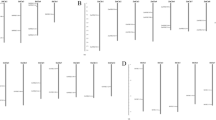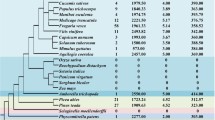Abstract
Tandemly arrayed genes (TAGs) account for about one-third of the duplicated genes in eukaryotic genomes. They provide raw genetic material for biological evolution, and play important roles in genome evolution. The 22-kDa prolamin genes in cereal genomes represent typical TAG organization, and provide the good material to investigate gene amplification of TAGs in closely related grass genomes. Here, we isolated and sequenced the Coix 22-kDa prolamin (coixin) gene cluster (283 kb), and carried out a comparative analysis with orthologous 22-kDa prolamin gene clusters from maize and sorghum. The 22-kDa prolamin gene clusters descended from orthologous ancestor genes, but underwent independent gene amplification paths after the separation of these species, therefore varied dramatically in sequence and organization. Our analysis indicated that the gene amplification model of 22-kDa prolamin gene clusters can be divided into three major stages. In the first stage, rare gene duplications occurred from the ancestor gene copy accidentally. In the second stage, rounds of gene amplification occurred by unequal crossing over to form tandem gene array(s). In the third stage, gene array was further diverged by other genomic activities, such as transposon insertions, segmental rearrangements, etc. Unlike their highly conserved sequences, the amplified 22-kDa prolamin genes diverged rapidly at their expression capacities and expression levels. Such processes had no apparent correlation to age or order of amplified genes within TAG cluster, suggesting a fast evolving nature of TAGs after gene amplification. These results provided insights into the amplification and evolution of TAG families in grasses.







Similar content being viewed by others
Abbreviations
- TAGs:
-
Tandemly arrayed genes
- UCO:
-
Unequal crossing over
- TEs:
-
Transposable elements
- LTR:
-
Long terminal repeat
- MITEs:
-
Miniature inverted repeat transposable elements
- SINEs:
-
Short interspersed repetitive elements
- mya:
-
Million years ago
References
Arora RK (1977) Job’s-tears (coix lacryma-jobi)—a minor food and fodder crop of northeastern India. Econ Bot 31:358–366
Bennetzen JL (2002) Mechanisms and rates of genome expansion and contraction in flowering plants. Genetica 115:29–36
Bennetzen JL (2007) Patterns in grass genome evolution. Curr Opin Plant Biol 10:176–181
Blanc G, Hokamp K, Wolfe KH (2003) A recent polyploidy superimposed on older large-scale duplications in the Arabidopsis genome. Genome Res 13:137–144
Bowers JE, Chapman BA, Rong J, Paterson AH (2003) Unravelling angiosperm genome evolution by phylogenetic analysis of chromosomal duplication events. Nature 422:433–438
Brunner S, Fengler K, Morgante M, Tingey S, Rafalski A (2005) Evolution of DNA sequence nonhomologies among maize inbreds. Plant Cell 17:343–360
Clarke BC, Mukai Y, Appels R (1996) The Sec-1 locus on the short arm of chromosome 1R of rye (Secale cereale). Chromosoma 105:269–275
Clayton WD (1983) Notes on the tribe Andropogoneae (Gramineae). Kew Bull 35:813–818
Clayton WD, Renvoize SA (1986) Genera Graminum. Grasses of the world. Her Majesty’s Stationery Office, London
DeRose RT, Ma DP, Kwon IS, Hasnain SE, Klassy RC, Hall TC (1989) Characterization of the kafirin gene family from sorghum reveals extensive homology with zein from maize. Plant Mol Biol 12:245–256
Devos KM, Brown JK, Bennetzen JL (2002) Genome size reduction through illegitimate recombination counteracts genome expansion in Arabidopsis. Genome Res 12:1075–1079
Ewing B, Hillier L, Wendl MC, Green P (1998) Base-calling of automated sequencer traces using phred. I. Accuracy assessment. Genome Res 8:175–185
Feng L, Zhu J, Wang G, Tang Y, Chen H, Jin W, Wang F, Mei B, Xu Z, Song R (2009) Expressional profiling study revealed unique expressional patterns and dramatic expressional divergence of maize alpha-zein super gene family. Plant Mol Biol 69:649–659
Fu H, Dooner HK (2002) Intraspecific violation of genetic colinearity and its implications in maize. Proc Natl Acad Sci USA 99:9573–9578
Gao S, Gu YQ, Wu J, Coleman-Derr D, Huo N, Crossman C, Jia J, Zuo Q, Ren Z, Anderson OD et al (2007) Rapid evolution and complex structural organization in genomic regions harboring multiple prolamin genes in the polyploid wheat genome. Plant Mol Biol 65:189–203
Gaut BS (2002) Evolutionary dynamics of grass genomes. New Phytol 154:15–28
Gaut BS, Doebley JF (1997) DNA sequence evidence for the segmental allotetraploid origin of maize. Proc Natl Acad Sci USA 94:6809–6814
Goff SA, Ricke D, Lan TH, Presting G, Wang R, Dunn M, Glazebrook J, Sessions A, Oeller P, Varma H et al (2002) A draft sequence of the rice genome (Oryza sativa L. ssp. japonica). Science 296:92–100
Gordon D, Abajian C, Green P (1998) Consed: a graphical tool for sequence finishing. Genome Res 8:195–202
Gu YQ, Crossman C, Kong X, Luo M, You FM, Coleman-Derr D, Dubcovsky J, Anderson OD (2004) Genomic organization of the complex alpha-gliadin gene loci in wheat. Theor Appl Genet 109:648–657
Hallauer AR, Miranda JB (1988) Quantitative genetics in maize breeding. Iowa State University Press, Ames, IA
International Rice Genome Sequencing Project (2005) The map-based sequence of the rice genome. Nature 436:793–800
Kawaura K, Mochida K, Ogihara Y (2005) Expression profile of two storage-protein gene families in hexaploid wheat revealed by large-scale analysis of expressed sequence tags. Plant Physiol 139:1870–1880
Kellogg EA (2001) Evolutionary history of the grasses. Plant Physiol 125:1198–1205
Kim WT, Okita TW (1988) Structure, expression, and heterogeneity of the rice seed prolamines. Plant Physiol 88:649–655
Lai J, Li Y, Messing J, Dooner HK (2005) Gene movement by Helitron transposons contributes to the haplotype variability of maize. Proc Natl Acad Sci USA 102:9068–9073
Li WH, Gu Z, Wang H, Nekrutenko A (2001) Evolutionary analyses of the human genome. Nature 409:847–849
Lin H, Ouyang S, Egan A, Nobuta K, Haas BJ, Zhu W, Gu X, Silva JC, Meyers BC, Buell CR (2008) Characterization of paralogous protein families in rice. BMC Plant Biol 8:18
Lisch D, Chomet P, Freeling M (1995) Genetic characterization of the Mutator system in maize: behavior and regulation of Mu transposons in a minimal line. Genetics 139:1777–1796
Ma J, Bennetzen JL (2004) Rapid recent growth and divergence of rice nuclear genomes. Proc Natl Acad Sci USA 101:12404–12410
Maere S, De Bodt S, Raes J, Casneuf T, Van Montagu M, Kuiper M, Van de Peer Y (2005) Modeling gene and genome duplications in eukaryotes. Proc Natl Acad Sci USA 102:5454–5459
Meng X, Huang B, Zhou L, He Y, Chen Q, Yuan Y, Xu Z, Song R (2010) Construction of a Coix BAC library and isolation of the 22 kDa α-coixin gene cluster. Genome 53:667–674
Messing J, Bharti AK, Karlowski WM, Gundlach H, Kim HR, Yu Y, Wei F, Fuks G, Soderlund CA, Mayer KF et al (2004) Sequence composition and genome organization of maize. Proc Natl Acad Sci USA 101:14349–14354
Morgante M, Brunner S, Pea G, Fengler K, Zuccolo A, Rafalski A (2005) Gene duplication and exon shuffling by helitron-like transposons generate intraspecies diversity in maize. Nat Genet 37:997–1002
Ohno S (1970) Evolution by gene duplication. Springer-Verlag, Heidelberg, Germany
Otto SP, Whitton J (2000) Polyploid incidence and evolution. Annu Rev Genet 34:401–437
Ottoboni LM, Leite A, Yunes JA, Targon ML, de Souza Filho GA, Arruda P (1993) Sequence analysis of 22 kDa-like alpha-coixin genes and their comparison with homologous zein and kafirin genes reveals highly conserved protein structure and regulatory elements. Plant Mol Biol 21:765–778
Paterson AH, Bowers JE, Chapman BA (2004) Ancient polyploidization predating divergence of the cereals, and its consequences for comparative genomics. Proc Natl Acad Sci USA 101:9903–9908
Rizzon C, Ponger L, Gaut BS (2006) Striking similarities in the genomic distribution of tandemly arrayed genes in Arabidopsis and rice. PLoS Comput Biol 2:e115
SanMiguel P, Gaut BS, Tikhonov A, Nakajima Y, Bennetzen JL (1998) The paleontology of intergene retrotransposons of maize. Nat Genet 20:43–45
Semple C, Wolfe KH (1999) Gene duplication and gene conversion in the Caenorhabditis elegans genome. J Mol Evol 48:555–564
Shantz HL (1954) The place of grasslands in the earth’s cover of vegetation. Ecology 35:143–145
Simillion C, Vandepoele K, Van Montagu MC, Zabeau M, Van de Peer Y (2002) The hidden duplication past of Arabidopsis thaliana. Proc Natl Acad Sci USA 99:13627–13632
Smith GP (1976) Evolution of repeated DNA sequences by unequal crossover. Science 191:528–535
Song R, Messing J (2002) Contiguous genomic DNA sequence comprising the 19-kD zein gene family from maize. Plant Physiol 130:1626–1635
Song R, Messing J (2003) Gene expression of a gene family in maize based on noncollinear haplotypes. Proc Natl Acad Sci USA 100:9055–9060
Song R, Llaca V, Linton E, Messing J (2001) Sequence, regulation, and evolution of the maize 22-kD alpha zein gene family. Genome Res 11:1817–1825
Song R, Llaca V, Messing J (2002) Mosaic organization of orthologous sequences in grass genomes. Genome Res 12:1549–1555
Swigonova Z, Lai J, Ma J, Ramakrishna W, Llaca V, Bennetzen JL, Messing J (2004) Close split of sorghum and maize genome progenitors. Genome Res 14:1916–1923
Tamura K, Dudley J, Nei M, Kumar S (2007) MEGA4: molecular evolutionary genetics analysis (MEGA) software version 4.0. Mol Biol Evol 24:1596–1599
The Arabidopsis Genome Initiative (2000) Analysis of the genome sequence of the flowering plant Arabidopsis thaliana. Nature 408:796–815
Tsubota SI, Rosenberg D, Szostak H, Rubin D, Schedl P (1989) The cloning of the Bar region and the B breakpoint in Drosophila melanogaster: evidence for a transposon-induced rearrangement. Genetics 122:881–890
Veit B, Vollbrecht E, Mathern J, Hake S (1990) A tandem duplication causes the Kn1-O allele of Knotted, a dominant morphological mutant of maize. Genetics 125:623–631
Vision TJ, Brown DG, Tanksley SD (2000) The origins of genomic duplications in Arabidopsis. Science 290:2114–2117
Wendel JF (2000) Genome evolution in polyploids. Plant Mol Biol 42:225–249
Xu JH, Messing J (2008) Organization of the prolamin gene family provides insight into the evolution of the maize genome and gene duplications in grass species. Proc Natl Acad Sci USA 105:14330–14335
Xu JH, Messing J (2009) Amplification of prolamin storage protein genes in different subfamilies of the Poaceae. Theor Appl Genet 119:1397–1412
Xu Z, Wang H (2007) LTR—FINDER: an efficient tool for the prediction of full-length LTR retrotransposons. Nucleic Acids Res 35:W265–W268
Yandeau-Nelson MD, Xia Y, Li J, Neuffer MG, Schnable PS (2006) Unequal sister chromatid and homolog recombination at a tandem duplication of the A1 locus in maize. Genetics 173:2211–2226
Yu J, Wang J, Lin W, Li S, Li H, Zhou J, Ni P, Dong W, Hu S, Zeng C et al (2005) The Genomes of Oryza sativa: a history of duplications. PLoS Biol 3:e38
Zhang L, Gaut BS (2003) Does recombination shape the distribution and evolution of tandemly arrayed genes (TAGs) in the Arabidopsis thaliana genome? Genome Res 13:2533–2540
Acknowledgments
We would like thank Yiwei Yuan for technical support on sequencing analysis, Yuanping Tang for sequence analysis. This work was supported by National Natural Sciences Foundation of China (30671303, 30700472), Ministry of Education of China (NCET-06-0435, 206048), Ministry of Science and Technology of China (2006AA10Z148, 2006AA10A107, 2009CB118400), Fok Ying Tung Education Foundation (101024), Science and Technology Commission of Shanghai Municipality (05PJ14049, 05QMX1424, 09DZ2271800), Education Commission of Shanghai Municipality (05ZZ02), and Shanghai Education Foundation (04SG40).
Author information
Authors and Affiliations
Corresponding author
Electronic supplementary material
Below is the link to the electronic supplementary material.
Rights and permissions
About this article
Cite this article
Zhou, L., Huang, B., Meng, X. et al. The amplification and evolution of orthologous 22-kDa α-prolamin tandemly arrayed genes in coix, sorghum and maize genomes. Plant Mol Biol 74, 631–643 (2010). https://doi.org/10.1007/s11103-010-9705-5
Received:
Accepted:
Published:
Issue Date:
DOI: https://doi.org/10.1007/s11103-010-9705-5




